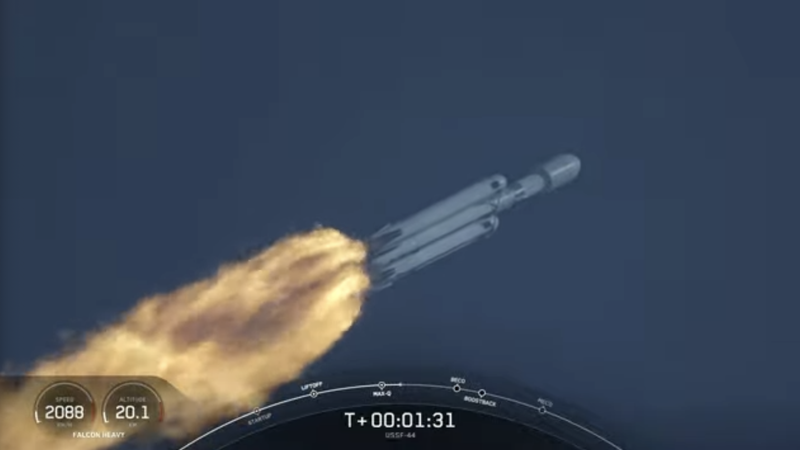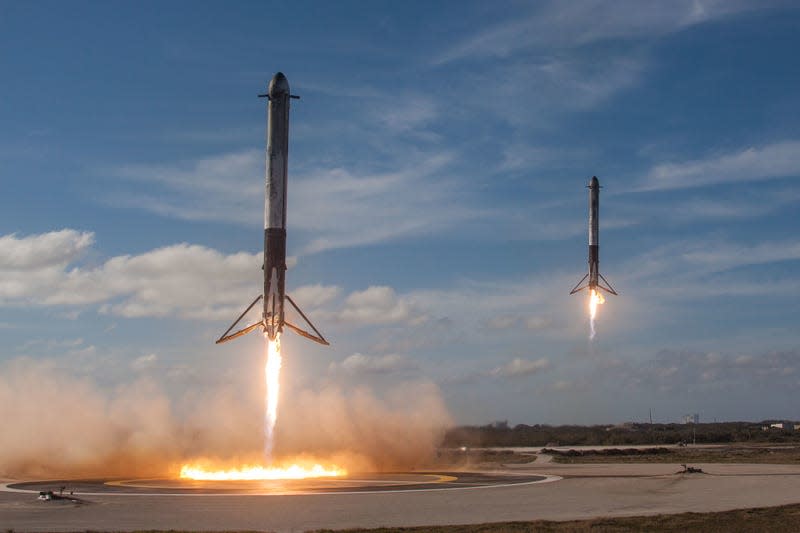SpaceX Launches Falcon Heavy for the First Time Since 2019

SpaceX launched a classified payload for the U.S. military on Tuesday morning with a Falcon Heavy—a giant rocket that hasn’t flown in three years.
Update: November 1, 10:02 a.m. ET: The Falcon Heavy blasted off at the designated time, but with unusually intense fog obscuring much of the view. The two side boosters performed as expected, executing successful vertical landings within seconds of one another. The payloads should arrive at geosynchronous orbit later today.
Read more
Original post follows.
The classified mission, named USSF-44, is slated to take flight on Tuesday, November 1 at 9:41 a.m. ET (1:41 p.m. UTC). The rocket is currently standing atop Launch Complex 39A at Kennedy Space Center in Florida, where the weather is expected to be excellent at the time of launch. SpaceX has set Wednesday aside for a second launch attempt, should that be necessary. You can watch the launch at SpaceX or at the feed below.
USSF-44 Mission
On Tuesday, the partially reusable heavy-lift launch vehicle will attempt to deliver its payloads directly to geosynchronous orbit (GEO), in what will be a first for SpaceX. As was the case during previous Falcon Heavy launches, the rocket’s two side boosters will attempt vertical landings at Landing Zone 1 and 2 at Cape Canaveral Space Force Station, while a recovery ship will gather the two fairing halves. As reported in Next Spaceflight, the two side boosters and the center core are newly built components.
The Falcon Heavy is currently the world’s most powerful rocket, but it’s set to be superseded by NASA’s Space Launch System (SLS) and SpaceX’s own Starship. The 230-foot-tall (70-meter) rocket is composed of three Falcon 9 engine cores, two of which serve as the side boosters. At liftoff, the 27 Merlin engines exert 5 million pounds of thrust. Falcon Heavy is capable of delivering 64 metric tons to low Earth orbit and 27 metric tons to geosynchronous orbit.

The rocket debuted in February 2018, when it famously carried SpaceX CEO Elon Musk’s Tesla Roadster to space. The rocket has only launched twice since then, the most recent being in June 2019. The paucity of launches has to do with the rocket’s excessive power and cost, as most satellite operators are simply looking to get their payloads to low Earth orbit, according to Space.com. Another reason has to do with the payloads themselves, which have been subject to development delays. USSF-44 was originally supposed to launch in late 2020, and NASA’s Psyche probe was supposed to launch this fall, for example.
As a classified mission, the rocket’s payloads this week are a bit of a mystery. Everyday Astronaut suspects the primary payload, USSF-44, is a military communications satellite. As many as six payloads could be heading to GEO, including the TETRA-1 prototype satellite built by Boeing subsidiary Millennium Space Systems and Lockheed Martin’s LINUSS-A 1 and LINUSS-A 2 cubesats.
Falcon Heavy has been idle, but the rocket is about to get busy, with a dozen missions scheduled across the next 12 months. These include another mission for the U.S. military, the launch of the Jupiter 3 commercial broadband satellite, and the aforementioned Psyche probe, which NASA will use to explore a metal-rich asteroid.
More: Pressed for Time, Amazon May Turn to Its SpaceX Rival for Satellite Launches
More from Gizmodo
The Best Shortcuts On Mac: Snap Windows, Text to Speech, and More
How to Delete Your Twitter Account If Elon Musk Was Your Last Straw
Sign up for Gizmodo's Newsletter. For the latest news, Facebook, Twitter and Instagram.

